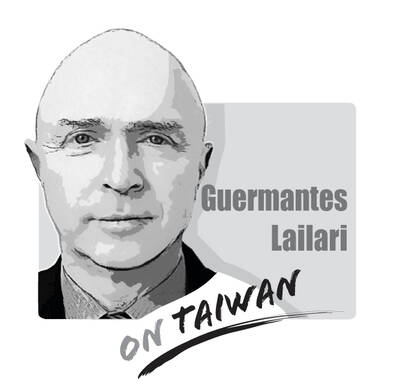Burkina Faso on Thursday announced that it was severing diplomatic ties with the Republic of China (ROC), and it on Saturday signed a joint communique with China to establish diplomatic relations with the People’s Republic of China (PRC).
The communique reads like a document from the 1950s, stating that there is only “one China” in the world, the PRC is the only legitimate government of the whole of China and Taiwan is part of China. It feels like China is still stuck in the Chinese Civil War.
However, the PRC is not the only one to blame. The ROC and the Constitution make it much easier to construct this kind of language, as they still claim that the ROC is the government of all of China, including Taiwan.
In the preamble of the last revision of the Constitution, it still says: “To meet the requisites of the nation prior to national unification.”
It also designates Taiwan as the “free area” of the ROC.
The ROC is a straitjacket that keeps Taiwan from developing its full potential as a nation on its own. How can other countries recognize Taiwan as the ROC, with all that that implies, without getting into the discussion of which is the legitimate government of China?
It is about time to dispose of this straitjacket and make Taiwan a real nation, so that other countries in the world can recognize it without getting involved in the never-ending Chinese Civil War.
It will take great effort and time to dispose of the ROC’s name and Constitution, and changing them abruptly might cause huge headaches to all concerned, but at least Taiwan should begin to “deROCize” by using the name “Taiwan” and not “ROC,” by diminishing the symbols of the ROC and increasing the visibility of the symbols of Taiwan, and by stopping to say that Taiwan is the ROC and the ROC is Taiwan.
Let people get used to Taiwan and let the ROC fade away, paving the way for a national referendum on a new Taiwanese Constitution.
The only country that can apply counterpressure against China’s moves is the US. It is also an opportunity — and excuse — to increase pressure on China for other reasons, such as trade, North Korea or the South China Sea, by raising the level at which Taiwan-US relations are conducted.
The US could send high-level officials to open the American Institute in Taiwan’s new office, invite Taiwan to participate in the US Navy’s yearly Rim of the Pacific Exercise, go ahead with US port calls in Taiwan and even visit Itu Aba (Taiping Island, 太平島)for oceanic research, perhaps.
Taiwan by itself can do very little to overcome the diplomatic challenge as long as it keeps the ROC’s name and Constitution, but as President Tsai Ing-wen (蔡英文) has said, Taiwan must work harder to strengthen non-diplomatic relations with other countries.
Taiwan does not need to be diplomatically recognized as the ROC and I do not mourn the loss of recognition by these small countries.
Why is it important to have these countries diplomatically recognizing the ROC? I have not seen a good explanation from anyone yet, because no one can explain what the ROC is in the real world at this time.
Sebo Koh is a former chairman of World United Formosans for Independence, USA and a former publisher of the US-based Taiwan Tribune.

Chinese state-owned companies COSCO Shipping Corporation and China Merchants have a 30 percent stake in Kaohsiung Port’s Kao Ming Container Terminal (Terminal No. 6) and COSCO leases Berths 65 and 66. It is extremely dangerous to allow Chinese companies or state-owned companies to operate critical infrastructure. Deterrence theorists are familiar with the concepts of deterrence “by punishment” and “by denial.” Deterrence by punishment threatens an aggressor with prohibitive costs (like retaliation or sanctions) that outweigh the benefits of their action, while deterrence by denial aims to make an attack so difficult that it becomes pointless. Elbridge Colby, currently serving as the Under
The Ministry of the Interior on Thursday last week said it ordered Internet service providers to block access to Chinese social media platform Xiaohongshu (小紅書, also known as RedNote in English) for a year, citing security risks and more than 1,700 alleged fraud cases on the platform since last year. The order took effect immediately, abruptly affecting more than 3 million users in Taiwan, and sparked discussions among politicians, online influencers and the public. The platform is often described as China’s version of Instagram or Pinterest, combining visual social media with e-commerce, and its users are predominantly young urban women,
Most Hong Kongers ignored the elections for its Legislative Council (LegCo) in 2021 and did so once again on Sunday. Unlike in 2021, moderate democrats who pledged their allegiance to Beijing were absent from the ballots this year. The electoral system overhaul is apparent revenge by Beijing for the democracy movement. On Sunday, the Hong Kong “patriots-only” election of the LegCo had a record-low turnout in the five geographical constituencies, with only 1.3 million people casting their ballots on the only seats that most Hong Kongers are eligible to vote for. Blank and invalid votes were up 50 percent from the previous
Japanese Prime Minister Sanae Takaichi lit a fuse the moment she declared that trouble for Taiwan means trouble for Japan. Beijing roared, Tokyo braced and like a plot twist nobody expected that early in the story, US President Donald Trump suddenly picked up the phone to talk to her. For a man who normally prefers to keep Asia guessing, the move itself was striking. What followed was even more intriguing. No one outside the room knows the exact phrasing, the tone or the diplomatic eyebrow raises exchanged, but the broad takeaway circulating among people familiar with the call was this: Trump did